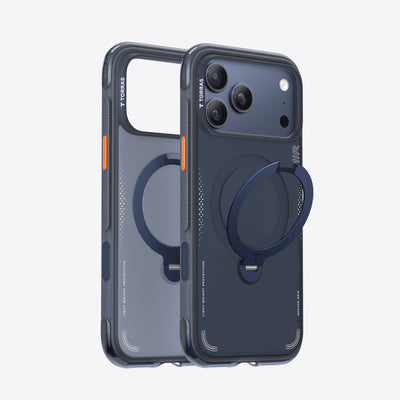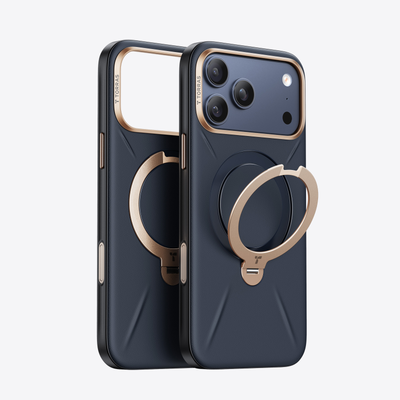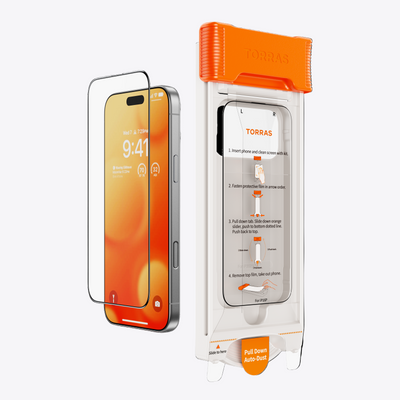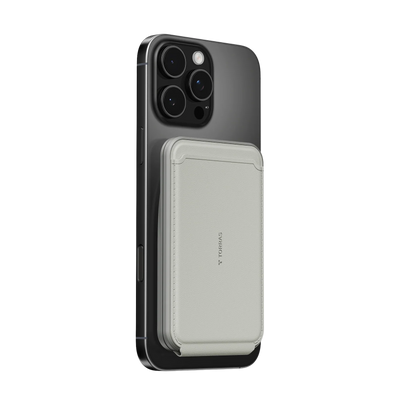If you own or plan to buy the iPhone 16 Pro Max, you may be wondering how strong its Ceramic Shield really is. This guide explains what Ceramic Shield is, where it is used, how it compares to other glass types, and the best ways to protect it.
What Ceramic Shield Actually Is
Ceramic Shield is glass that is infused with nano-ceramic crystals during the manufacturing process. This creates a structure that is harder to crack while keeping the transparency and responsiveness you expect from premium smartphone glass. Apple introduced this material to reduce the likelihood of shattering when a phone is dropped. While it offers improved protection compared to traditional glass, it is not indestructible. Sharp particles, repeated impacts, and edge hits can still cause damage.
Where Ceramic Shield Is Used on the iPhone 16 Pro Max
On the iPhone 16 Pro Max, Ceramic Shield covers only the front glass. This is the surface you interact with most, so it benefits most from impact protection. The back is made from textured matte glass, which has a premium look and feel but does not have ceramic reinforcement. If the phone falls on its back or hits a hard object, the rear glass can still crack and often requires costly repairs.
How Ceramic Shield Compares to Other Glass Types
Ceramic Shield vs. Gorilla Glass
Gorilla Glass is used in many Android smartphones and is chemically strengthened to resist damage. Both Gorilla Glass and Ceramic Shield undergo ion-exchange processes to toughen the glass, but Ceramic Shield includes nano-ceramic crystals that improve its fracture toughness. In real-world drop tests, Ceramic Shield often performs better against cracks from certain heights, especially in flat drops. Gorilla Glass may sometimes have slightly better scratch resistance depending on the model.
Ceramic Shield vs. Sapphire Glass
Sapphire glass, often found on luxury watches and some smartphone camera lenses, is extremely scratch-resistant but more brittle when dropped. Ceramic Shield takes a balanced approach, offering strong drop resistance and moderate scratch resistance. Sapphire might remain visually pristine for longer, but it is more likely to shatter on impact compared to Ceramic Shield.
What Makes Ceramic Shield Unique
Ceramic Shield is manufactured through a dual-ion exchange process and infused with ceramic particles. This combination delivers clarity, thinness, and durability. Unlike some protective materials that can reduce screen brightness or affect touch accuracy, Ceramic Shield is designed to be virtually invisible to the user, so you get protection without losing display quality or touch responsiveness.

How Ceramic Shield Performs in the Real World
Having Ceramic Shield is one thing, but how does it hold up in everyday use?
Drop Resistance Benefits
Tests and user reports show that Ceramic Shield can survive more drops from pocket or chest height without shattering compared to standard glass. The added toughness is especially noticeable in flat-on-surface impacts. However, no glass is immune to damage. Angled impacts or falls onto hard, uneven surfaces can still cause cracks.
Scratch Resistance Limitations
Ceramic Shield is harder to crack but it is not scratch-proof. Fine particles like sand and other minerals are harder than glass and can leave permanent marks. Keeping your phone in the same pocket as keys or coins increases the risk of scratching. Even wiping the screen with a dusty cloth can cause micro-abrasions.
How It Holds Up in Real Life
Most owners see fewer cracks from everyday drops compared to older iPhones. Without a screen protector, however, small scratches tend to appear over time, especially in areas where fingers swipe most often. These micro-scratches can slightly dull the display and lower resale value.
Common Problems and How to Solve Them
Even with Ceramic Shield, these issues are still common but preventable.
Micro-Scratches Appearing Early
Solution: Use a high-quality tempered glass screen protector to absorb scratches that would otherwise damage the Ceramic Shield. Avoid placing your phone face down on rough surfaces and keep it away from sand or grit. Always clean your screen with a microfiber cloth rather than clothing.
Cracked Corners After Drops
Solution: The corners of your phone are vulnerable because impact forces are concentrated there. Use a case with reinforced corners or air-cushion technology to absorb shock and reduce the chance of cracks spreading across the screen.
Back Glass Still Breaking
Solution: The back glass is not ceramic-reinforced, so it can crack more easily. A case with a raised back and camera bump protection will help prevent direct impacts. This is especially useful if you often place your phone on hard surfaces like stone or tile.
How to Protect Your iPhone 16 Pro Max Ceramic Shield
The best way to maintain Ceramic Shield is to pair it with the right accessories and good daily habits.
Why Extra Protection Is Still Worth It
Ceramic Shield reduces the chance of breakage but it is not invincible. Extra protection extends its life and keeps your phone looking premium.
Step 1 – Choose a Quality Screen Protector
Pick tempered glass or high-grade film with full coverage, and look for extras like anti-glare or fingerprint-resistant coatings.
The TORRAS GlassGo Screen Protector is built with triple ion-exchange technology for 9H hardness, the same rating as professional safety glass. It absorbs impacts from daily drops and bumps. Its 99.99 percent light transmittance keeps your Super Retina XDR display bright and true to color, while the Tora-Silk coating resists smudges. Installation is quick and bubble-free thanks to the included InstaFit frame and cleaning kit.
Step 2 – Pick the Right Case Material
-
TPU: Flexible, shock-absorbing, and lightweight for all-around use.
-
Silicone: Soft, grippy feel that reduces slip risk, though it may attract lint.
-
Leather: Premium look and feel with lighter impact resistance.
Step 3 – Match Protection Level to Your Needs
-
Light protection: Slim case for office or low-risk environments.
-
Rugged protection: Drop-tested case for outdoor work, sports, or if you often drop your phone.
Step 4 – Keep It Clean
Wipe your phone regularly with a microfiber cloth and mild cleaner. Avoid high-alcohol solutions, abrasive pads, or paper towels.
Step 5 – Avoid Damage Risks
Do not store your phone with keys, coins, or sand. Use a separate padded pocket in your bag to prevent scratches or cracks.
Repair Costs and How to Avoid Them
AppleCare+ Pricing
With AppleCare+, screen repairs cost a fixed low fee, much less than paying full price. It also covers multiple accidental damage incidents, which is helpful for heavy users.
Out-of-Warranty Costs
Without coverage, an iPhone 16 Pro Max screen replacement can cost several hundred dollars. Back glass repairs can be even more expensive because the entire housing may need to be replaced.

How to Lower Your Risk of Expensive Repairs
Combine a tempered glass screen protector and a sturdy case with AppleCare+ for maximum protection and peace of mind. For a complete solution, check out the TORRAS iPhone 16 Pro Max cases, designed to safeguard your device in real-world conditions without sacrificing comfort or style. Each case is precision-molded for a perfect fit, with military-grade drop protection that absorbs shocks from accidental falls. Raised bezels keep the screen and camera lenses elevated from flat surfaces to reduce scratch risk. Many designs are MagSafe-compatible, ensuring strong magnetic alignment for wireless charging and accessories. Materials range from soft, grippy silicone to durable PC and TPU blends, offering impact resistance with lightweight handling. Whether you prefer a slim daily cover or a rugged outdoor shield, TORRAS cases protect your iPhone 16 Pro Max while keeping it looking premium.
Frequently Asked Questions
Does the iPhone 16 Pro Max have Ceramic Shield on the back?
No. The back glass is textured matte glass without ceramic reinforcement.
Can Ceramic Shield still scratch?
Yes. It is drop-resistant but not scratch-proof. Fine particles like sand can still leave marks.
Does Ceramic Shield cover the camera lenses?
No. The camera lenses use sapphire crystal for their own protection.
Will Ceramic Shield last the life of the phone?
Yes, if it is not physically damaged. A screen protector and case will help it stay in like-new condition longer.
Conclusion
Ceramic Shield on the iPhone 16 Pro Max is one of the toughest front glass options available today, giving you better drop protection than standard glass. However, it is not immune to scratches or cracks, especially from angled impacts or abrasive materials. By combining it with a quality screen protector like the TORRAS GlassGo, using a protective case, and practicing simple care habits, you can keep your display looking flawless and avoid costly repairs. With the right protection strategy, your iPhone can maintain both its beauty and performance for years to come.




![[US Only] FlexLine Retractable Fast Charger 40W](http://torraslife.com/cdn/shop/files/charging_yoga_40w_product_01_400x400.png?v=1759994549)
